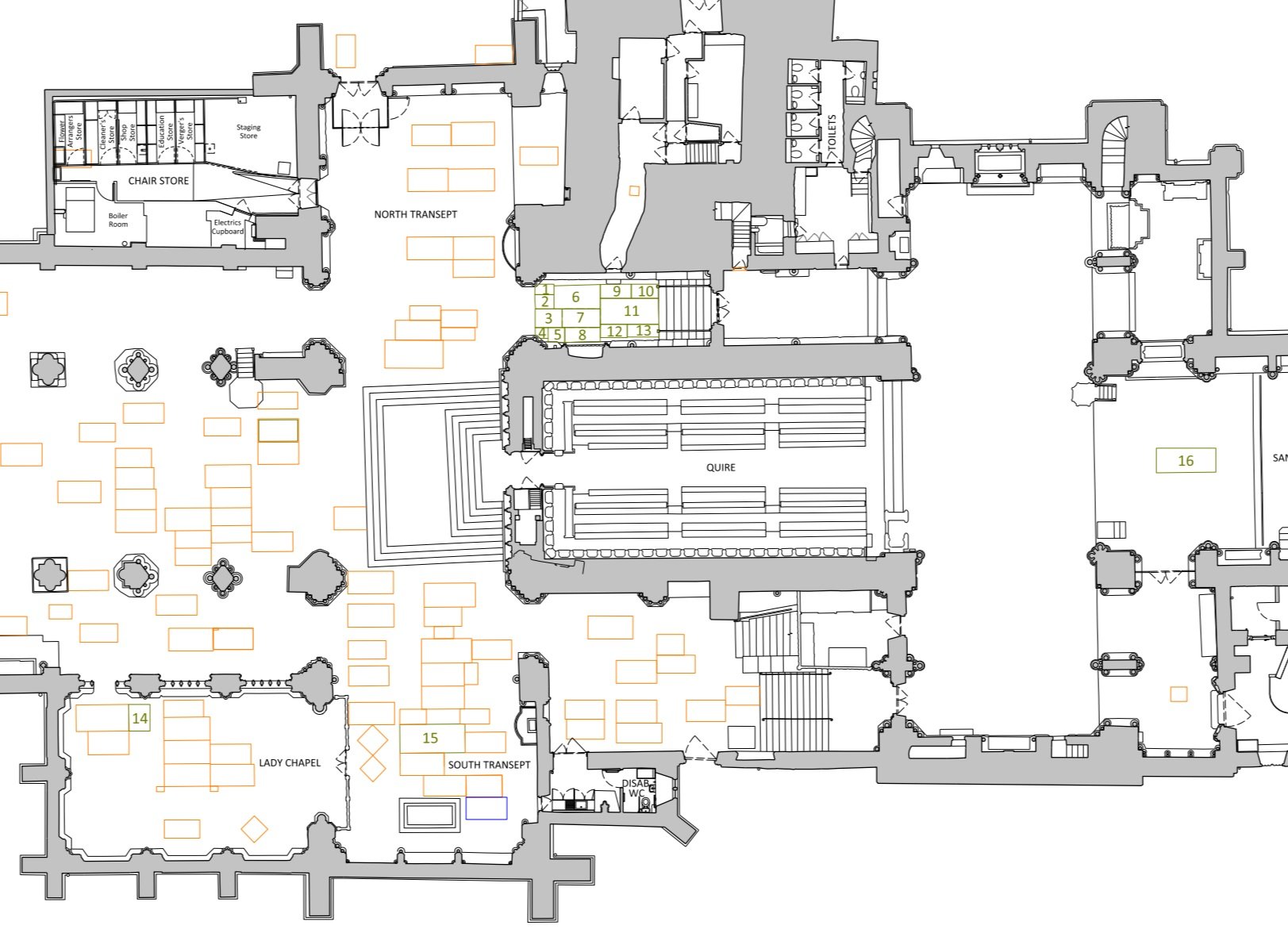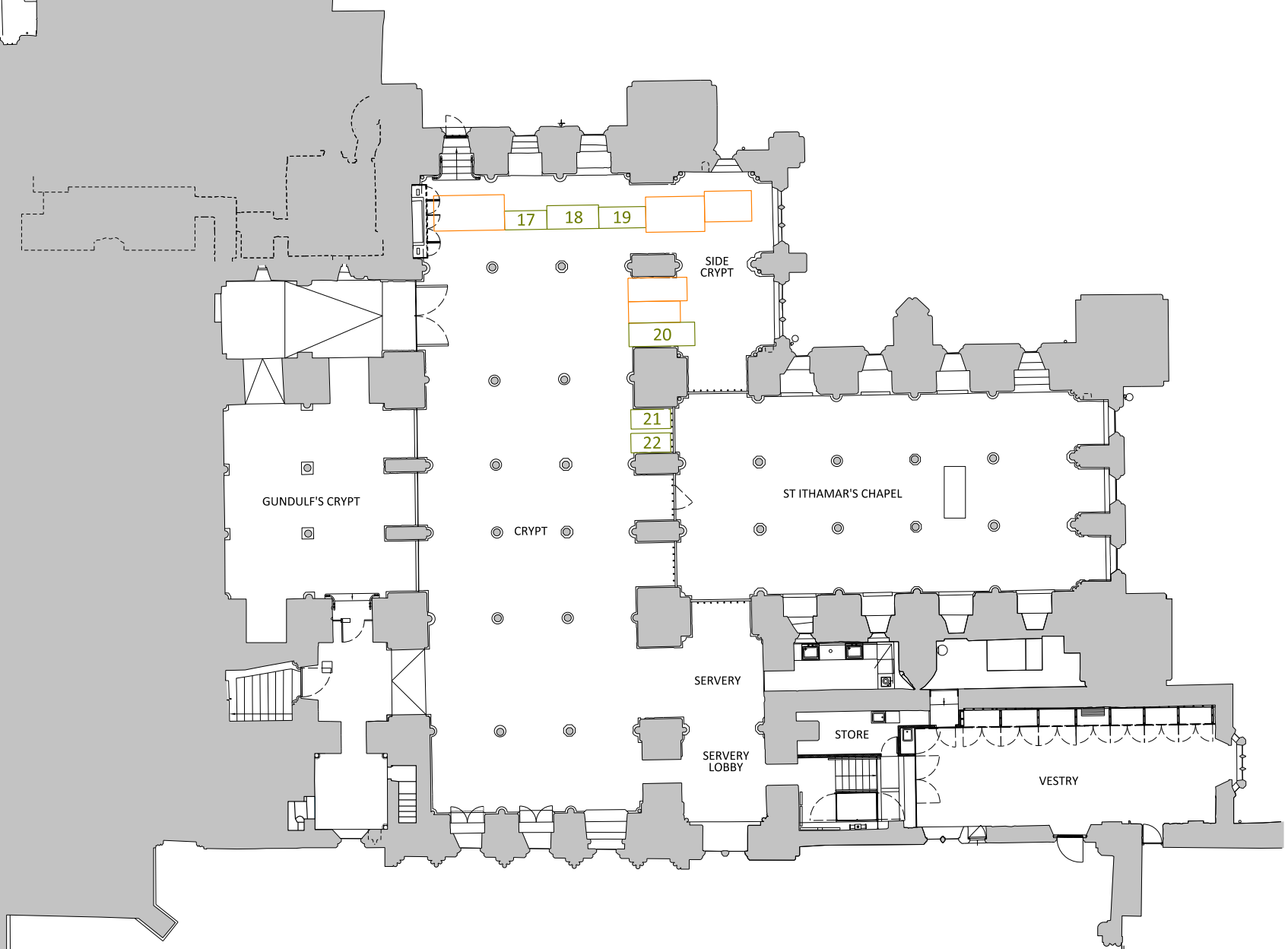Brass casements and ledger stones
/Dr John Physick studies the medieval brasses in the floor of the North Quire Aisle and the ledger stones throughout the nave. Featured in The Friends of Rochester Cathedral Annual Report for 1990.
They are to be found in every cathedral and pm almost every medieval church; they have all been walked on for generations, and to a very large extent, they have rarely been mentioned in any guide book. They are the slabs of Purbeck marble retaining the shadows of long-stolen monumental brasses and the slabs, about seven feet long, usually of black marble, marking the location of a burial or a burial vault from the 17th century onwards. As they are part of the they have all been walked on for generations, and to a very large extent, they have rarely been mentioned in any guide book. They are the slabs of Purbeck taining the shadows of long-stolen monumental brasses and the seven feet long usually or black marble making the lepatco the floor, it is often their bad luck to have been disregarded during various internal alterations, or sometimes they have been moved, cracked and broken, to another part of the church; perhaps they have been buried unrecorded beneath pew platforms, and sometimes portions peep tantalisingly from underneath choir stalls.
The indents of monumental brasses have always attracted attention, but the ledger stones (or grave stones) have rarely done so. In the second decade of the 18th century an antiquarian, John Le Neve, published, five volumes of monumental inscriptions between 1717 and 1719, entitled Monumenta Anglicana. These inscriptions had been collected from a variety of correspondents and the total number published ran into hundreds, but was only a small portion of the thousands then in existence, many of which cannot now be traced. There is nothing for Rochester, but when I had recently to visit a small and fairly remote village church in the neighbouring diocese of Canterbury, I took with me details of an inscription from Le Neve and was gratified to see it on a black marble stone in the centre of the nave, hardly damaged after nearly three hundred years,
Rochester Cathedral too, as it has not been overwhelmed by visitors, managed to preserve its ledger stone relatively unscathed, in the nave, transepts and aisles, unlike those in, for instance, Westminster Abbey, which have been almost entirely worn away by the shuffling feet of millions of visitors.
There are twelve monumental brass indents, of which only one is identifiable. This is behind the High Altar and consequently frequently overlooked. The Purbeck marble slab is about ten feet in length, and on it are the sunken outlines of a knight and lady, Sir William Arundel (died 1400) and his wife (died 1401). In the centre of the Presbytery is the equally large slab of marble with the indent of a bishop in vestments, wearing a mitre and holding a crozier.
Keyplan of brasses on the ground floor. Touch to open PDF
Crypt
Keyplan of brasses in the crypt. Touch to open PDF
There are two other indents of the brasses of bishops, one in the south nave transept, and the other at the foot of the steps leading eastwards from the north nave transept. Unfortunately this large piece of Purbeck marble has been broken into three pieces. However, it is surrounded by several other more minor indents, which leads one to suppose that they all have been relocated from other areas of the cathedral.
The ledger stones range in date from the late 17th century until after last war.
One of the earliest is that of Richard Sommer in the crypt, and is not in good condition. Sommer, who died in 1682, has a mural monument at the west end of the north nave aisle. Probably one or the other has been moved. Another ledger that has been divorced from its mural monument is of almost the same date, but it is in a much better condition, although it is fully exposed in the north nave transept. At the head is a carved heraldic shield (as was often the case), and in fine incised Roman letters is the inscription:
Memoria Sacru
AUGUSTINI CASARIS
Medicine Doctoris
Qui Anno Dom. MDCLXXXIII
Augusti die VI|m
Mortalitati Valedixit
The monument, now on the south wall of the north choir aisle, was once adjacent to the ledger stone, on the east wall of the north nave transept. There is a discrepancy in the death date: the gravestone is clearly incised MDCLXXXIII
(1683), while buried in the lengthy Latin and Greek inscription of the monument is MDCLXXVII (1677). Probably the more immediate ledger is correct, as the monument is London work, and the letter cutter worked from a pen draft, which he could have misread, or which itself may have been incorrect.
Adjacent to the Caesar ledger is another well preserved slab with good lettering:
S. To The Memory of
M°S Margaret Pymm
One of the Daughters of
FINCH DERING of
CHEARING in this County ESq3 and Widdow of JOHN PYMM Gen'
Who exchanged this Life for a Better on the 20th of March
Anno Dom
168¾
This somewhat surprising date reminds us of the lengthy period when England kept aloof from the rest of Europe. The year date changed from March to January but England persisted in the March date until it fell into line and adopted the reformed Gregorian calendar (1582) in 1752. Due to the fact that century years do not count as leap years, the country found itself eleven days adrift from the continent, and this had to be adjusted. The result was, of course, riots as the unsophisticated population thought that the government had shortened life by eleven days. Another ledger with a dual date is in the Lady Chapel, of a twelve year old girl, Margaret Pulman who died on 17 March 1719/20. By today's reckoning the death date could be corrected to 1720 New Style.
At the east end of the nave is a family group of graves of the Barrell family, with dates ranging from 1679, when Francis Barrell, Recorder of Rochester died.
Adjacent is the ledger of his wife:
HERE LIES
THE BODY OF ANNE BARREL
THE WIFE OF
FRANCIS BARRELL
SERIT AT LAW
WhO DYED YE 14T OF IAÑ
1707
Not far away, on the wall of the north nave aisle are two mural monuments, one to the Recorder, and the other to another Francis Barrell (d. 1772) on which he is recorded as 'the last Male Heir'.
Probably the most memorable of the ledgers in the Cathedral is that in the Lady Chapel, with a sculpted hand pointing to an oval with a high relief of the Good Samaritan:
SACRED
To the Memory of
FREDERICK HILL Gen
Who
Anno Domini 17 B dam ind the Widow of
THOMAs KNACKSTON.
To whof Children.
Two Sons and Three Daughters, His CONDUCT
Was
Affectionate and Boúntifull.
In the molt tender
Parental Sente:
In his Publick Truf
ichince for His Maieltys Sick and Wounded,
At this Port, So Fair:
Such His Love augt Gure for them
Solely Obervant of
The Seal of His Office)
That Thought for Or luftice to Himfell,
Was his laft. as Leaft Concern:
*gretted las Greatly belov by all who Knew hin beine a Rind Neichbours Ancere Friend In Dilcasi
In all, there is a total of about 80 ledgers in the Cathedral (at least one is under the nave altar platform). Most are in a good state of preservation with crisp lettering, but with an increase in visitors, wear and tear will eventually take their toll. Before it is too late, all the inscriptions should be recorded and rubbings taken from the lettering. Much is, of course important for local history, such as that of the Revd. John Benson, 'Ecclesiae de Halstow superiori per Annos triginta duos Pastor fidelis'. Perhaps this recording is something that a few enthusiastic Friends might undertake.
Before switching off from floors, it should be noted that there are a few patches of medieval tiles, but special mention has to be made of the splendid array of encaustic tiles in the Presbytery and North choir transept, laid by Sir Gilbert Scott. I doubt whether anyone has yet made a serious study of this floor, but there are dragons, fleurs-de-lis, various patterns, wheel windows, crowned heads, a horse with a flag, and what looks like a cat with one raised paw. At least one tile, of a set of four, has been laid (or perhaps replaced) wrongly. Has anyone noticed it?
Anvone interested in indents, ledger stones, and encaustic tiles should read Historic Floors: Their History and Conservation, 1998, edited by Jane Fawcett and published by Is i..ration with ICOMOS UK
North choir transept, laid by Sir Gilbert Scott. I doubt whether anyone has yet made a serious study of this floor, but there are dragons, fleurs-de-lis, various patterns, wheel windows, crowned heads, a horse with a flag, and what looks like a cat with one raised paw. At least one tile, of a set of four, has been laid (or perhaps replaced) wrongly. Has anyone noticed it?
Anyone interested in indents, ledger stones, and encaustic tiles should read Historic Floors: Their History and Conservation, 1998, edited by Jane Fawcett and published by Butterworth and Heineman in association with ICOMOS UK (the International Council for Monuments and Sites). There are twenty chapters written by architects, conservators and historians, and deal with recording, conservation and photography, among other subjects





